As the cold winter season approaches, it’s about time to check on the condition of your car heater. Car interior heating is every driver’s best friend when it comes to staying warm and comfortable during those chilly days. To make sure your car heater is functioning as it should, it’s a good idea to understand how a car heater works in the first place.
How Does a Heater in a Car Work?
An internal combustion engine naturally produces heat every time it’s turned on. But how exactly does this heat enter and regulate the temperature inside a cold cabin? Well, it’s all thanks to the car heating system, which consists of the following parts:
- Heater core
- Blower motor
- Heater hoses
- Heater control valve
- Heating, ventilation, and air conditioning (HVAC) control panel
These components work hand-in-hand with the cooling system’s coolant, thermostat, radiator, and water pump. In other words, the vehicle’s cooling system has to work for the heating system to work.

When the coolant passes through the engine, it picks up heat to prevent the engine from overheating. This coolant then flows through the radiator, where the heat is dissipated. However, when you turn on your car heater on a vehicle with a heater control valve, some of the hot coolant flows from the engine to the heater core.
As the air passes through the fins of the heater core, the warmth is distributed to the floor, the windshield or the dash register as selected by the driver.
When the engine is cold and the thermostat is closed, most engine platforms will bypass the thermostat and send the hot water through the heater core for quick cabin heat. But even after the thermostat opens, the water pump still pumps hot coolant through the heater core.
How Do Vehicles Regulate Cabin Temperature?
Older vehicles are usually equipped with a water-valve system that determines how much coolant flows to the heater core depending on the cabin temperature set by the driver.
On the other hand, modern cars tend to use an air-blending system that uses flaps to let in cold outside air to mix with the heated air. This allows the hot air to cool down and reach the desired cabin temperature. This is called a “blend door” and is designed to blend hot and cold air as you turn the temperature knob on your A/C control head.

Why Your Car Heater Isn’t Working
Is there anything worse than a car heater that refuses to work in the winter? Not only is it uncomfortable and distracting, it can also be dangerous, especially in harsh climates. Here are the common reasons why your car heating system might be acting up:
Low Coolant Levels
If your engine is already hot but the heater isn’t blowing hot air, you could be dealing with low coolant levels. Automotive heating systems rely on coolant to function properly, which means insufficient coolant will prevent it from getting hot air into the cabin.
Low coolant is typically caused by a leak in the cooling system or by seepage into the cylinders past the head gasket over time. This creates air pockets.
To get rid of these air pockets, you’ll have to first fix the leak (if it’s a hose, water pump, etc.,) and then fill the cooling system carefully to make sure all the air pockets are gone. Some cooling systems have bleeder valves that are supposed to be opened when the coolant is being added with the engine off.
Weak Water Pump

The water pump in the photo is from a Ford Taurus that had no cabin heat but was full of coolant and wasn’t overheating, but the water pump wasn’t able to pump coolant through the heater core. Replacing the water pump restored the heater core coolant supply.
Damaged Blower Fan Motor
Is your auto heater blowing out little to no air even after turning it to the highest setting? This is likely caused by a damaged blower fan motor. It might feel warm inside your cabin, but the air likely isn’t circulating as it should.
When checking the motor, it’s also a good idea to inspect its fuse, resistor, ground circuit, and wiring too. Of course, if the blower is running, there’s no need to check all these things.
Faulty Thermostat
A car with a heater that refuses to blow hot air might be hiding a faulty thermostat under the hood. When a thermostat is stuck open, the engine takes longer to warm up. The engine is likely to stay cold, preventing the heater from releasing hot air into the cabin. Typically this will turn on a Check Engine Light and set a code P0125.
A faulty thermostat will typically turn on a Check Engine Light and set a code P0125.
– Richard McCuistian, ASE Certified Master Automobile Technician
Worn or Clogged Heater Core
The culprit behind the chilly temperature in your cabin might just be a clogged heater core. This generally happens when the cooling jacket is loaded with rust, which will settle in the heater core and clog it to the point that no coolant can flow through.
A worn heater core can also start to leak, causing coolant levels to drop along with the temperature in your cabin. You’ll have to replace the heater core with a new one.
Stuck Blend Door
When you turn on the heater, the blend door shuts off the airflow from the A/C, allowing only hot air from the heater to enter the cabin. Of course, this also works in reverse. The blend door can block hot air from entering the heater to allow only cold air to flow into the cabin. When the blend door gets stuck in this position, hot air won’t enter from the vents.
If the blend door is fine, inspect the blend door actuator next. The actuator controls the blend door’s movements, which means it can easily stop hot air from entering your cabin if it fails.
How To Keep the Heater in Good Condition
Keeping your car heater in good condition is all about proper maintenance. This includes regularly topping off your coolant and making sure it’s clean. Follow your manufacturer’s recommended mix of antifreeze and water, and watch out for any leaks.
You’ll have to inspect the different components of your car heating system as well, including the thermostat, water pump, radiator, and heater core. Don’t ignore any issues you spot, and consult a mechanic as soon as possible.
How Often Should You Inspect Your Car Heater?
When in doubt, it’s always best to follow your manufacturer’s recommended service interval, but inspecting your heating system at least once a year should be fine. It’s best to do it ahead of winter, so you can be ready before the snow settles. Regular inspections can go a long way in catching any problems before they get worse.
How Often Do You Need New Coolant?
The exact interval can vary depending on several factors, including your vehicle’s year, make, and model, so check your vehicle’s specific maintenance schedule to be sure. In general, however, it’s best to flush and top off your car’s coolant every 30,000 miles, but some allow for 100,000 miles coolant changes. Keeping coolant levels high and making sure there are no leaks will help your car heater work efficiently.
Where to Get High-Quality Heating Components for Your Vehicle
Having a functional heater is crucial, especially during the cold winter months. So it’s in your best interest to replace any faulty component that can make your vehicle’s heating system malfunction. The best way to do this is to order high-quality heating components at CarParts.com.
All our parts pass the highest quality control standards from industry professionals. That means you can count on them to perform like your stock part and last a long time. We make purchasing car parts online easier by providing accurate and detailed fitment information, making for a straightforward and hassle-free shopping experience.
Use our vehicle selector to narrow down the catalog to the parts that fit your ride. Then, adjust the filters to view the products that match your preferred brand, price, and features.
Order the replacement heating component you need at CarParts.com!
Any information provided on this Website is for informational purposes only and is not intended to replace consultation with a professional mechanic. The accuracy and timeliness of the information may change from the time of publication.







































